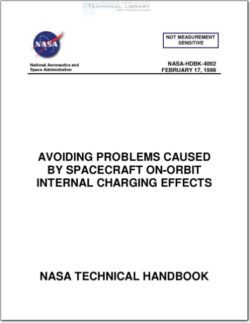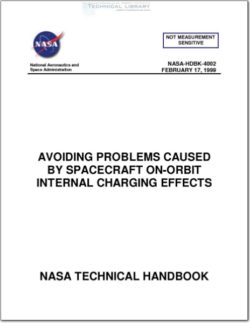NASA-HDBK-4002

- Version
- 214 Downloads
- 542.90 KB File Size
- 1 File Count
- May 14, 2016 Create Date
- May 14, 2016 Last Updated
Avoiding Problems Caused by Spacecraft On-Orbit Internal Charging Effects

1. SCOPE
1.1 Scope. This document establishes guidelines and design practices to be used by
NASA and other spacecraft designers to minimize the detrimental effects of spacecraft internal
charging. These effects are due to interactions between the in-flight plasma environment and
spacecraft electronic systems. The detrimental effects are disruption or damage from
electrostatic discharges (ESD’s) at interior regions of the spacecraft that may be charged by
space plasmas. The handbook applies to any spacecraft whose circular Earth orbit is described
by the labeled regions of Figure 1, as well as other energetic plasma environments such as at
Jupiter. Designs for spacecraft with orbits in these regions should be examined for the threat
from internal charging. This document does not train the reader to do the necessary design
work; program managers must use knowledgeable ESD experts for design evaluations.
In this handbook, the distinction between “surface charging”and ‘internal charging”is that
internal charging is caused by energetic penetrating particles that can penetrate and deposit
charge very close to a victim site. Surface charging is on areas that can be seen and touched
on the outside of a spacecraft. Surface discharges occur on or near the outer surface of a
spacecraft and discharges must be coupled to an interior victim. Discharge energy from surface
arcs is attenuated by the coupling factors, and therefore is less threat to internal electronics.
External wiring and antenna feeds of course are susceptible to this threat. Internal charging, by
contrast, may cause a discharge directly to a victim pin or wire with very little attenuation.
Geosynchronous/geostationary orbit (a circular orbit in the equatorial plane of the Earth at
~35,063 km altitude) is perhaps the most common example of a region where spacecraft are
NASA-HDBK-4002
February 17, 1999
affected by internal ESD’s, but the same problem can occur at lower Earth altitudes, polar
orbits, and at Jupiter.
This handbook details the methods and designs necessary to mitigate on-orbit internal charging
problems. Control and mitigation of surface charging is treated in NASA TP2361, ‘Design
Guidelines for Assessing and Controlling Spacecraft Charging Effects”[Purvis et al., 1984].
1.2 Purpose. The purpose of this handbook is two-fold. First, it is intended to serve as a
single reference source that contains suggested detailed spacecraft design requirements and
procedures to minimize the effects of spacecraft internal charging and to limit the effects of the
resulting ESD. Secondly, it contains supplementary material and references to aid
understanding and assessing the magnitude of the phenomenon.
| File | Action |
|---|---|
| NASA-HDBK-4002 Avoiding Problems Caused by Spacefcraft On-Orbit Internal Charging Effects.pdf | Download |

Comment On This Post